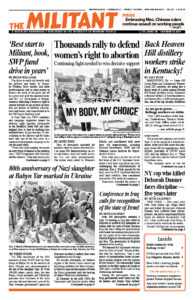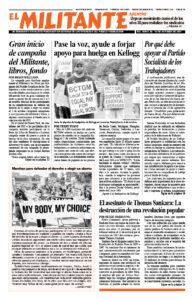The 80th anniversary of the 1941 massacre of over 30,000 Jews by Nazi troops at Babyn Yar on the outskirts of Kyiv, Ukraine, was commemorated at the site of the slaughter Sept. 29. Over 100,000 others, mostly Jews, but also Roma, Soviet prisoners and Ukrainian partisans were butchered at the same spot over the next two years, part of the Nazi German government’s genocidal Holocaust in which 6 million Jews were slaughtered across Europe.
For decades afterwards, the Stalinist regime in the Soviet Union covered up the killings at Babyn Yar. But it ultimately failed to wipe out the memory of what the Nazis perpetrated with the backing of rightist Ukrainian collaborators.
In Germany in the early 1930s the Communist and Socialist parties failed to seize the opportunity to lead workers to take power during a severe crisis and rising working-class struggles. Growing sections of the capitalist class turned to Adolph Hitler’s fascists to smash these struggles and preserve their rule. Nazis scapegoated Jews for the economic and social crisis, launching murderous assaults on them, and on the unions, militant workers and communists.
Under Nazi rule Berlin prepared for the coming world war, fought to seize markets and territory from the German rulers’ rivals in the U.K. and U.S., and against the Soviet Union.
German forces swept into Poland and then invaded the Soviet Union, occupying Kyiv in 1941. They ordered all Jews in the city to go to the train station, spreading rumors they would be sent to Palestine. They were marched to the ravine at Babyn Yar, stripped and shot dead by the thousands over Sept. 28-29. Only 29 survived. In 1939, prior to the German invasion, the Jewish population of Kyiv was 175,000. Today there are only 48,000 Jews in the entire country.
This year’s commemoration of Babyn Yar included a march retracing the steps of those killed at the ravine. Ukrainian President Volodymyr Zelenskyy attended. Schools held special programs about what had happened that day. A further commemoration in Kyiv on Oct. 6 was attended by Israeli President Isaac Herzog.
Stalinists perpetuate Nazi cover-up
To erase all evidence of the massacre, Nazi units brought Jews from nearby concentration camps to exhume and burn the bodies at Babyn Yar in 1943.
After the defeat of the Nazis, the Stalinist bureaucracy in Moscow reestablished power over Ukraine, and continued to cover up the slaughter of the Jews. Stalin had led a counterrevolution in the 1920s against the program of the Bolshevik-led 1917 socialist revolution, which brought workers and farmers to power.
The Bolshevik government, led by V.I. Lenin, put an end to pogroms targeting Jews under the rule of the czars. It guaranteed Jews political rights and encouraged a revival of Jewish culture. It also granted self-determination and autonomy to nations like Ukraine, which had long been oppressed by Moscow.
A vital part of the Stalin-led counterrevolution was a reign of terror against workers and revolutionaries in Ukraine. Policies under Lenin granting Ukrainian self-determination were overturned. A revival of Jew-hatred was another consequence. “The leading cadre of the bureaucracy at the center and in the provinces strives to divert the indignation of the working masses from itself to the Jews,” Bolshevik leader Leon Trotsky said from exile in 1937.
From 1948 the Soviet bureaucracy increased its Jew-hating attacks. It arrested Jewish writers and intellectuals. Just prior to Stalin’s death in 1953 it fabricated the slanderous “Doctors Plot,” framing-up Jewish doctors for alleged plans to poison government officials.
To end persistent pressure for a memorial at Babyn Yar, the Stalinist rulers planned to fill the ravine and turn it into a sports stadium in 1957. But pressure to tell the truth would not go away.
In 1961 poet Yevgeny Yevtushenko visited the ravine and wrote the poem, “Babyn Yar.” It begins “No monument stands over Babyn Yar.” When Yevtushenko met Soviet Premier Nikita Khrushchev in 1962, he read him the last lines of his poem:
“In my blood there is no Jewish blood.
But all anti-Semites hate me with
Encrusted spite as if I were a Jew.
And because of that — I’m a true Russian.”
“Comrade Yevtushenko, this poem has no place here,” Khrushchev scolded him. Earlier that year, Khrushchev had claimed, “There is no Jewish question in our country.” When Yevtushenko visited revolutionary Cuba and wrote a poem extolling its internationalism the Stalinist regime revoked his passport.
In 1966, on the 25th anniversary of the massacre, thousands gathered at the ravine for an unauthorized rally. Among those who spoke there was Ivan Dzyuba, a communist from Ukraine.
“Babyn Yar is a tragedy of the whole of mankind,” Dzyuba told the gathering. “But it happened on Ukrainian soil. And therefore a Ukrainian must not forget it any more than a Jew.
“We, the Ukrainians, should combat in our midst any manifestation of anti-Semitism, or disrespect to a Jew, and the incomprehension of the Jewish problem.”
Dzyuba wrote Internationalism or Russification? in defense of Lenin’s policies in the 1920s that were overthrown by Stalin.
By 1976 officials erected a monument at Babyn Yar, but it made no mention of the fact that a huge majority of the victims were killed because they were Jewish. It was only with the fall of the Stalinist regime in Moscow in 1991 and Ukrainian independence that authorities finally erected a monument recognizing what the Nazis did was in fact part of the Holocaust.
The commemoration is important for working people. It is a reminder of the price humanity pays if a party isn’t built that can lead millions of workers and farmers to take political power from the capitalist class when that becomes possible. Only by doing so can we prevent fascists from unleashing genocidal assaults on Jews, like that at Babyn Yar, and stop them from crushing the labor movement as they drive to salvage and perpetuate capitalist exploitation.


